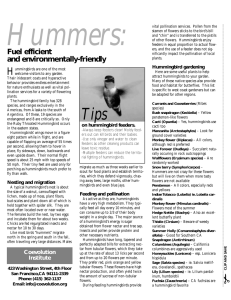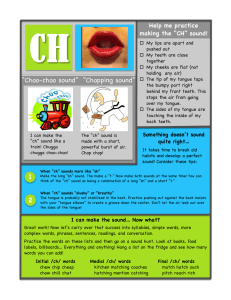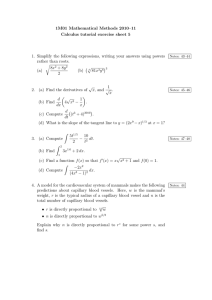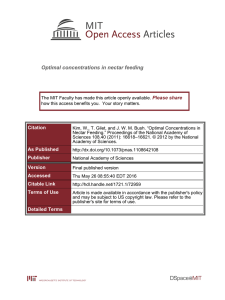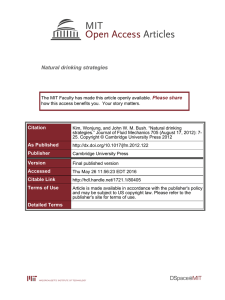Reply to Rico-Guevara and Rubega: Nectar loading in hummingbirds Please share
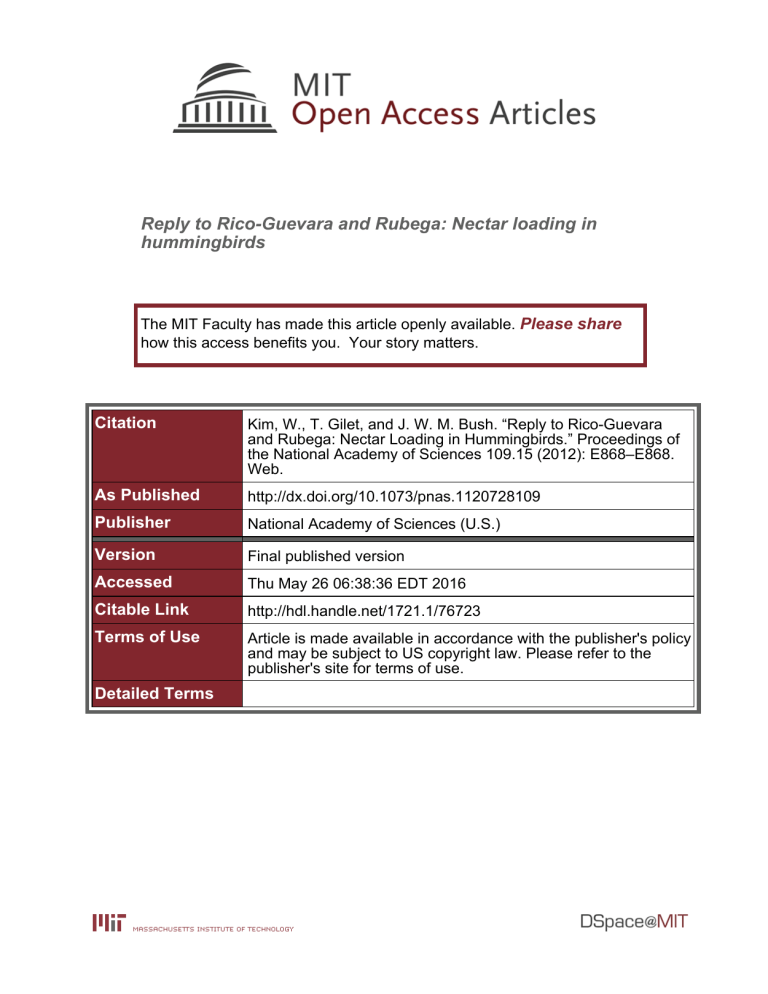
Reply to Rico-Guevara and Rubega: Nectar loading in hummingbirds
The MIT Faculty has made this article openly available.
Please share
how this access benefits you. Your story matters.
Citation
As Published
Publisher
Version
Accessed
Citable Link
Terms of Use
Detailed Terms
Kim, W., T. Gilet, and J. W. M. Bush. “Reply to Rico-Guevara and Rubega: Nectar Loading in Hummingbirds.” Proceedings of the National Academy of Sciences 109.15 (2012): E868–E868.
Web.
http://dx.doi.org/10.1073/pnas.1120728109
National Academy of Sciences (U.S.)
Final published version
Thu May 26 06:38:36 EDT 2016 http://hdl.handle.net/1721.1/76723
Article is made available in accordance with the publisher's policy and may be subject to US copyright law. Please refer to the publisher's site for terms of use.
LETTER
Reply to Rico-Guevara and Rubega:
Nectar loading in hummingbirds
Our article (1) provided a rationale for the vast volume of biological data (20 species of birds, bats, and insects) on optimal nectar concentrations measured in a laboratory setting. The comment of Rico-Guevara and Rubega (2) bears on our footnote, where the relative importance of nectar transport via trapping and capillary rise in the speci fi c case of hummingbird feeding is brie fl y touched on. The point of their comment is evidently to contest the fact that hummingbirds use capillary suction, so as to defend their claim to the contrary (3).
It has been known for over a century that hummingbirds can use capillary suction (4). In their recent article in PNAS,
Rico-Guevara and Rubega (3) pointed out the role of tongue fl exibility in hummingbird drinking, demonstrating that surface tension-induced closure of the tongue can trap nectar
(5). Although the viability of this fl uid-trapping mechanism is not in doubt, it does not preclude capillary suction. As evidenced by our observations (movie S1 in ref. 1) and those of
Rico-Guevara and Rubega (3), both can occur. It is obvious that capillary rise can be advantageous to the hummingbird; moreover, it is straightforward to calculate the relative ef fi ciency of the two techniques for a given fl uid and tongue kinetics. The test of a theoretical model is its ability to rationalize data.
Our model satisfactorily rationalizes the optimal concentration data of many species widely believed to use capillary suction, including the hummingbird.
There was very little information given in our footnote because it was neither central to the theme of the paper nor a source of data for our study. Rather, it was included as clear evidence that hummingbirds can feed via capillary suction, as was oddly contested by Rico-Guevara and Rubega (3). For the sake of clearing up two minor mistakes in describing the sequence, we include a full description here. Movie S1 in ref. 1 shows the tongue of a live Ruby-throated hummingbird
( Archilochus colubris ) that vertically immerses its tongue into a sucrose solution [20% (wt/wt), density of 1,080 kg/m 3 , and viscosity of 1.9 mPa · s]. The frame rate is 2,000 frames/s, the running time is 0.082 s, and the fi eld of view is 1.9 mm × 11.6
mm. The tongue extension is ∼ 15 mm. Similar tongue motions were observed with another hummingbird. The bubble apparent at the beginning of movie S1 in ref. 1 indicates that the tongue is initially wet. When the tongue tip is inserted in the bath, the retraction speed is less than 7 cm/s, and thus greatly exceeded by the capillary rise speed of ∼ 18 cm/s. Once loaded by capillary suction, the tongue retracts, with peak speeds of 33 cm/s. The inference of capillary rise in our experiments, which Rico-Guevara and Rubega (2) refer to as
“ unrealistic ” and “ misguided, ” is indisputable.
We thus see no reason to reconsider our original inference concerning the mechanism of nectar loading in hummingbirds. The comments of Rico-Guevara and Rubega (2) have no bearing on our original conclusions concerning the rationale for observed optimal concentrations across a broad class of nectar-feeding creatures.
Wonjung Kim a
, Tristan Gilet
Departments of b
, and John W. M. Bush b,1 a
Mechanical Engineering and b
Mathematics,
Massachusetts Institute of Technology, Cambridge, MA 02139
1. Kim W, Gilet T, Bush JW (2011) Optimal concentrations in nectar feeding.
Proc Natl
Acad Sci USA 108:16618 – 16621.
2. Rico-Guevara A, Rubega MA (2012) Hummingbird feeding mechanics: Comments on the capillarity model.
Proc Natl Acad Sci USA 109:E867.
3. Rico-Guevara A, Rubega MA (2011) The hummingbird tongue is a fl uid trap, not a capillary tube.
Proc Natl Acad Sci USA 108:9356 – 9360.
4. Kingsolver JG, Daniel TL (1983) Mechanical determinants of nectar feeding strategy in hummingbirds: Energetics, tongue morphology, and licking behavior.
Oecologia 60:
214 – 226.
5. Chang K (November 24, 2009) How hummingbirds get their nectar from tiny “ straws.
” NY
Times , p. D3. Available at http://www.nytimes.com/2009/11/24/science/24obhummingbird.
html?emc=eta1. Accessed November 23, 2009.
Author contributions: W.K., T.G., and J.W.M.B. wrote the paper.
The authors declare no con fl ict of interest.
1
To whom correspondence should be addressed. E-mail: bush@math.mit.edu.
E868 | PNAS | April 10, 2012 | vol. 109 | no. 15 www.pnas.org/cgi/doi/10.1073/pnas.1120728109

